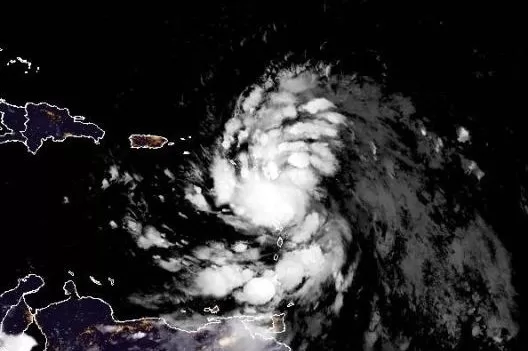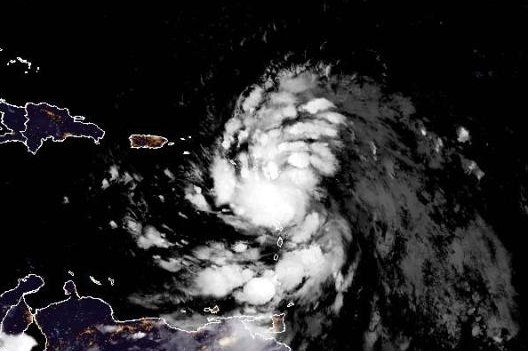Tropical Storm Ernesto, which became the fifth named storm of the hurricane season on Monday, was expected to travel over the Leeward Islands early Tuesday. Photo courtesy National Oceanic and Atmospheric Administration
Aug. 13 (UPI) — Tropical Storm Ernesto was heading for the Leeward Islands early Tuesday, hours after it became the fifth named storm of the Atlantic hurricane season.
In its 2 a.m. update, the National Hurricane Center located Ernesto about 100 miles southeast of Antigua and 385 miles east-southeast of San Juan, Puerto Rico.
It had maximum sustained winds of 40 mph, maintaining the same strength it had when declared a tropical storm at 5 p.m. Monday.
NHC said the storm is expected to move over the Leeward Islands in the next few hours.
After moving over portions of the Leeward islands Tuesday morning, Ernesto is expected to move near or over the U.S. and British Virgin Islands and Puerto Rico by Tuesday night. Ernesto is then forecast to turn northward over the western Atlantic.
Tropical storm warnings are in effect for St. Kitts, Nevis, Montserrat, Antigua, Barbuda, Anguilla; Guadeloupe, St. Martin and St. Barthelemy, Sint Maarteen British Virgin Islands, U.S. Virgin Islands, Puerto Rico, Vieques and Culebra.
“Ernesto is expected to bring tropical storm conditions to portions of the Leeward Islands beginning early Tuesday and to the Virgin Islands and Puerto Rico by late Tuesday,” the NHC said in a discussion on the system, warning that heavy rainfall may cause “considerable flash flooding and mudslides” in areas of the Leeward and Virgin islands through Wednesday and over Puerto Rico late Tuesday into Thursday.
In the Leeward and Virgin islands, Ernesto is expected to produce 4 to 6 inches of rain and 3 to 6 inches with maximum amounts of 10 inches over Puerto Rico.
Puerto Rico Gov. Pedro Pierluisi mobilized the Puerto Rico National Guard on Monday. And the start of the school year was delayed.
Plans are underway in several Puerto Rican communities regarding the availability of supplies, backup services and flood mitigation.
“After the experience with Hurricane María, we have established that immediately there is a particular event there is a group of employees already duly assigned to throw themselves [into the streets] and attend to the main roads,” Aibonito Mayor William Alicea told El Nuevo. “The problem is that people go crazy removing debris.”
Hurricane Maria in 2018 caused an estimated $90 billion in damage in Puerto Rico and the U.S. Virgin Islands, NHC said. Maria was the most destructive hurricane to hit Puerto Rico in modern times and the third costliest hurricane in U.S. history behind Katrina and Harvey.
Maria also knocked down 80% of Puerto Rico’s utility poles and all transmission lines, resulting in loss of power to essentially all of the island’s 3.4 million residents. Nearly all cellphone and municipal water supplies also were knocked out.
Ernesto Morales, a National Weather Service meteorologist and warnings coordinator, told The San Juan Daily Star, the atmospheric system could cause rains, floods, landslides and dangerous maritime conditions.
Debby was a Category 1 storm that made landfall in the Florida Panhandle and then moved through the U.S. Atlantic Coast last week.
Beryl struck parts of the Caribbean, the Yucatán Peninsula and the Gulf Coast of the United States in late June and early July.
Two tropical storms were in the Gulf of Mexico in June: Cindy and Alberto.

